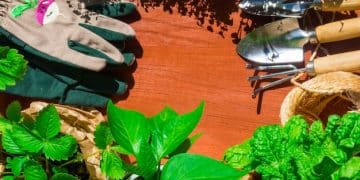Grow 50% Produce, Reduce Carbon: Sustainable Gardening this Summer

Achieving up to 50% self-sufficiency in produce this summer through sustainable gardening significantly reduces your carbon footprint, fostering local food systems and healthier living with minimal environmental impact.
Imagine stepping into your backyard this summer and harvesting fresh, organic produce that makes up half of your family’s dietary needs. This vision isn’t just a dream; it’s an achievable goal with dedicated efforts in Sustainable Gardening: Grow 50% of Your Own Produce This Summer and Reduce Your Carbon Footprint. Beyond the obvious benefits of fresh food, this approach carries profound environmental advantages, transforming your outdoor space into a beacon of ecological responsibility and personal well-being.
The urgency for sustainable gardening
In an era defined by climate change and increasing environmental awareness, the choices we make, even in our backyards, hold significant weight. Conventional food systems, with their reliance on long-distance transportation, chemical fertilizers, and extensive water consumption, contribute substantially to greenhouse gas emissions and environmental degradation. Sustainable gardening emerges as a powerful antidote, offering a localized solution that benefits both personal health and planetary well-being. It is more than a hobby; it is a vital practice for a resilient future.
Reducing your carbon footprint through food choices is one of the most impactful personal actions you can take. Every mile your food travels, every synthetic input used in its production, adds to the environmental burden. By growing even a portion of your own food, you bypass these energy-intensive processes. Furthermore, cultivating your garden fosters biodiversity, improves soil health, and can even contribute to local microclimates. The connection it builds between you and your food source is an invaluable, often overlooked, benefit.
Understanding the carbon footprint of food
The journey from farm to fork involves a complex web of activities, each with its own environmental cost. Transportation is a major contributor, with produce often traveling thousands of miles to reach your plate. Refrigeration, processing, and packaging further exacerbate energy consumption. Consider the sheer volume of fuel consumed, the emissions released, and the waste generated from this global supply chain. This context underscores the profound impact of local, home-grown food.
Moreover, modern industrial agriculture frequently depletes soil nutrients, relies heavily on fossil fuel-derived fertilizers, and can contaminate water sources with pesticide runoff. These practices not only degrade the environment but also affect the nutritional quality of the food itself. Sustainable gardening, in contrast, emphasizes practices that replenish the soil, conserve water, and avoid harmful chemicals. It’s a holistic approach that sees the garden as an ecosystem.
- Reduced food miles: Eliminates long-distance transportation of produce.
- Less packaging: Significantly cuts down on plastic and other packing materials.
- Minimized waste: Freshly harvested produce means less spoilage and food waste.
- Lower chemical input: Avoids synthetic fertilizers and pesticides.
Embracing sustainable methods means a conscious decision to nurture the environment from your own plot of land. It’s an active step towards self-sufficiency and a stronger connection to the natural world. This initial investment in understanding the “why” behind sustainable gardening sets the stage for practical implementation and long-term success.
Designing your productive sustainable garden
A successful sustainable garden begins with thoughtful design. It’s not about randomly planting seeds but strategically planning your space to maximize yield, conserve resources, and integrate seamlessly with your local ecosystem. This holistic approach considers everything from sunlight patterns to water availability and local wildlife. An intentional design can dramatically increase your chances of reaching the goal of growing 50% of your own produce.
Start by observing your outdoor space. Note how sunlight moves across your yard throughout the day, especially during the peak growing season. Most vegetables require at least 6-8 hours of direct sunlight daily to thrive. Understanding shaded areas versus full sun zones will inform where you place your most demanding crops. Also, assess your soil type and drainage. Healthy soil is the foundation of a productive garden, and understanding its composition is the first step in amending it for optimal growth.
Strategic plant placement for maximum yield
Once you understand your garden’s microclimates, you can begin to plan plant placement. Consider vertical gardening to maximize space, especially in smaller urban areas. Trellises, arbors, and hanging baskets can support climbing plants like tomatoes, cucumbers, and beans, allowing them to grow upwards rather than spreading out. This not only saves ground space but also improves air circulation, reducing the risk of disease.
Companion planting is another key element of sustainable design. Certain plants benefit from being grown near each other, either by deterring pests, attracting beneficial insects, or improving soil nutrients. For example, planting marigolds near vegetables can deter nematodes, while basil can enhance the flavor of tomatoes. Researching compatible plant pairings for your chosen crops can significantly boost your garden’s health and productivity without resorting to chemical interventions.
- Sun mapping: Identify full sun, partial sun, and shade areas.
- Soil testing: Understand soil pH and nutrient levels for targeted amendments.
- Vertical solutions: Utilize trellises and containers to grow upwards.
- Companion planting: Leverage beneficial plant relationships for natural pest control and growth.

Water-wise design is also paramount. Group plants with similar water needs together to optimize irrigation efficiency. Consider installing a drip irrigation system or soaker hoses, which deliver water directly to the plant roots, minimizing evaporation and runoff. Integrating rain barrels to capture rainwater can further reduce your reliance on municipal water sources, contributing to both sustainability and cost savings.
Building soil health and fertility
The cornerstone of a highly productive and sustainable garden lies beneath your feet: the soil. Healthy soil is a living ecosystem, teeming with microorganisms, fungi, and insects that work in concert to provide nutrients to plants, retain water, and sequester carbon. Neglecting soil health is akin to building a house on a weak foundation; no matter how much effort you put into planting, the results will be suboptimal. Focusing on soil fertility is an investment that pays dividends in bountiful harvests and resilient plants.
Conventional gardening often relies on synthetic fertilizers, which can deplete the soil’s natural biology over time, leading to a dependency on external inputs. Sustainable gardening, by contrast, emphasizes building the soil’s inherent fertility through organic matter. This approach creates a self-sustaining system where the soil largely takes care of itself, mimicking natural forest ecosystems where nutrients are constantly recycled.
Composting: your garden’s gold mine
Composting is arguably the most powerful tool a sustainable gardener possesses. It transforms kitchen scraps, yard waste, and other organic materials into nutrient-rich humus, a dark, crumbly substance that dramatically improves soil structure, water retention, and nutrient availability. Regular application of compost enriches the soil with essential macronutrients and micronutrients, fostering a vibrant microbial community that supports plant growth.
- Kitchen scraps: Vegetable and fruit peels, coffee grounds, eggshells.
- Yard waste: Leaves, grass clippings, small twigs.
- Avoid: Meat, dairy, diseased plants, pet waste, and chemically treated materials.
Beyond providing nutrients, compost also enhances soil structure, making heavy clay soils more workable and improving the water retention of sandy soils. It acts as a sponge, holding moisture and releasing it slowly to plant roots, reducing the need for frequent watering. This not only conserves water but also promotes deeper root growth, making plants more resilient to drought and nutrient deficiencies. Establishing a functional compost system, whether a simple pile or a dedicated bin, is a non-negotiable step toward sustainable gardening success. Regularly turning your compost pile accelerates decomposition and ensures a balanced, nutrient-rich end product.
Water conservation and efficient irrigation
Water is a precious resource, and its efficient use is critical for sustainable gardening. Traditional watering methods can be wasteful, with much of the water evaporating before reaching plant roots or running off into drains. To achieve a 50% homegrown produce goal, a robust and water-conscious irrigation strategy is essential. It’s about getting the right amount of water to the right place at the right time, minimizing loss and maximizing absorption.
Understanding your plants’ water needs is the first step. Different vegetables have varying requirements; for instance, leafy greens generally need more consistent moisture than root vegetables like carrots. Observing your plants and the soil will provide crucial clues. Wilting leaves are an obvious sign of thirst, but checking the soil moisture a few inches down can give a more accurate picture of whether watering is truly needed.
Optimizing water delivery systems
Drip irrigation and soaker hoses are game-changers for water efficiency. These systems deliver water directly to the plant’s root zone, virtually eliminating evaporation and runoff. Unlike overhead sprinklers, which can lead to significant water loss to the air and foliage (potentially encouraging fungal diseases), drip systems ensure every drop counts. Setting these systems on a timer further optimizes water use, allowing for deep, infrequent watering that encourages strong root development.
- Drip irrigation: Delivers water slowly, directly to roots.
- Soaker hoses: Ideal for rows, allowing water to seep into the soil.
- Rain barrels: Collect free rainwater, reducing reliance on municipal supply.
Beyond these systems, cultural practices also play a vital role. Mulching heavily around your plants significantly reduces soil moisture evaporation, suppresses weeds, and moderates soil temperature. A layer of organic mulch, such as straw, wood chips, or shredded leaves, can cut water needs by as much as 25-50%. Watering deeply and infrequently encourages roots to grow deeper, making plants more resilient to dry spells. Combining these methods culminates in a water management strategy that not only conserves resources but also nurtures a healthier, more productive garden ecosystem.
Pest and disease management without chemicals
Relying on synthetic pesticides and fungicides to combat garden pests and diseases is contrary to the principles of sustainable gardening. These chemicals can harm beneficial insects, contaminate soil and water, and even pose risks to human health. A truly sustainable approach focuses on prevention and natural controls, fostering a balanced garden ecosystem where pests are managed rather than eliminated through brute force. This requires patience, observation, and an understanding of the intricate relationships within your garden.
The first line of defense is a healthy, diverse garden. Strong, well-nourished plants are naturally more resistant to pests and diseases. Providing them with rich soil, adequate sunlight, and proper watering builds their inherent immunity. Diversifying your plant choices also helps; a monoculture (growing large quantities of a single crop) is an open invitation for pests specific to that plant to proliferate. Intercropping different types of vegetables, herbs, and flowers creates a more complex environment that confuses pests and provides habitat for their natural enemies.
Beneficial insects and natural deterrents
Encouraging beneficial insects is a cornerstone of organic pest control. Ladybugs love to munch on aphids, while lacewings prey on a variety of soft-bodied insects. Planting flowers that attract these helpful predators, such as dill, cilantro, yarrow, and cosmos, turns your garden into a natural pest management hub. Creating small habitats, like brush piles or small ponds, can also encourage amphibians and birds that feed on slugs and other garden nuisances.
- Attract predators: Plant flowers that draw beneficial insects.
- Crop rotation: Prevents pest buildup in the soil.
- Hand-picking: Manually remove larger pests like hornworms.
- Neem oil: A natural, organic pesticide for tougher infestations.
Physical barriers, such as row covers, can protect young seedlings from early season insect damage without the need for sprays. Introducing companion plants that naturally repel pests is another effective strategy; for example, marigolds deter nematodes, and strongly scented herbs like rosemary and mint can confuse cabbage moths. When an infestation does occur, resorting to targeted, least-toxic solutions like insecticidal soap or neem oil is preferable to broad-spectrum chemicals. Vigilance and a proactive approach ensure that your garden remains productive and environmentally sound, reflecting true sustainable gardening principles.
Maximizing your harvest and extending the season
To truly achieve the goal of growing 50% of your own produce, it’s not enough to simply plant a garden; you must maximize its output and extend the harvest season as much as possible. This involves smart planting strategies, continuous harvesting, and protective measures against adverse weather. It’s about making every square foot count and ensuring a year-round supply of fresh produce, even if the primary goal is focused on summer output.
Succession planting is a key technique for maximizing yield. Instead of planting all of one crop at once, plant smaller batches every few weeks. This ensures a continuous harvest rather than a single large one, which can lead to gluts and wasted produce. For example, plant a small row of lettuce every two weeks throughout spring and early summer. As one batch finishes, another is ready for harvest, ensuring a steady supply.
Season extension techniques
Pushing the boundaries of the traditional gardening season can significantly increase your total yield. Simple techniques like using cold frames, hoop houses, or even just row covers can protect plants from early spring frosts and extend production into late fall or even winter in some climates. These micro-climates allow you to start seeds earlier and keep mature plants producing longer, contributing substantially to your 50% self-sufficiency target.
- Succession planting: Stagger planting times for continuous harvest.
- Cold frames: Protect early and late season crops from frost.
- Hoop houses: Provide significant warmth and protection for extended growing.
- Strategic variety selection: Choose plants with differing maturity rates.

Choosing the right plant varieties also plays a crucial role. Opt for heat-tolerant varieties for summer production and cold-hardy options for shoulder seasons. Look for “bush” varieties for space efficiency and “determinate” tomatoes if you prefer a concentrated harvest for canning. Regular harvesting not only provides fresh produce but also encourages many plants, like beans and zucchini, to continue producing more. Allowing plants to go to seed prematurely can signal the end of their productive phase, so consistent harvesting is vital for ongoing yield. By combining these methods, you transform your garden from a seasonal endeavor into a continuous source of fresh, sustainable food, getting closer to that ambitious 50% goal.
The broader impact and personal benefits
Achieving the goal of growing 50% of your own produce this summer and significantly reducing your carbon footprint extends far beyond the confines of your garden fence. It represents a tangible commitment to environmental stewardship, personal health, and community resilience. The ripple effects of each sustainable gardening choice contribute to a larger movement towards a more sustainable and equitable food system, proving that individual actions can indeed create collective change.
Environmentally, every homegrown fruit and vegetable bypasses the energy-intensive processes of industrial agriculture: long-haul transportation, synthetic inputs, and excessive packaging. This direct connection to your food source offers a powerful counter-narrative to a system often perceived as distant and unsustainable. You become an active participant in carbon sequestration through healthy soil, water conservation, and biodiversity promotion, turning your backyard into a micro-habitat supporting local ecosystems.
Health and well-being gains
The personal benefits are equally compelling. Consuming fresh, organic produce immediately after harvest means experiencing peak nutritional value and unparalleled flavor. Homegrown food often contains higher levels of vitamins, minerals, and antioxidants compared to their store-bought counterparts, which may have traveled extensively and been harvested prematurely. The physical activity involved in gardening is a gentle yet effective form of exercise, promoting cardiovascular health and muscle strength.
Beyond the physical, gardening offers profound mental and emotional benefits. The act of nurturing life, observing natural cycles, and connecting with the earth can be incredibly therapeutic, reducing stress and fostering a sense of accomplishment. It’s a mindful practice that encourages presence and patience. Sharing your bounty with neighbors cultivates community ties, potentially inspiring others to embark on their own sustainable gardening journeys and fostering local food sharing networks.
- Nutritional superiority: Fresher, more nutrient-dense food.
- Physical activity: Gentle exercise and outdoor engagement.
- Mental well-being: Stress reduction and a sense of accomplishment.
- Community building: Sharing produce fosters stronger local connections.
Ultimately, sustainable gardening is an empowering act of self-reliance and environmental responsibility. It transforms concern into action, demonstrating that a significant impact can be made at the individual level. By embracing these practices, you not only feed your family wholesome food but also contribute to a healthier planet, one garden plot at a time. The cumulative effect of many individuals adopting these practices is what will drive the necessary societal shift toward more sustainable living.
| Key Point | Brief Description |
|---|---|
| 🌱 Optimized Design | Strategic placement and companion planting maximize yield and conserve resources. |
| 🌍 Carbon Reduction | Growing food at home eliminates food miles and reduces reliance on industrial agriculture. |
| 💧 Smart Water Use | Drip irrigation, mulching, and rain collection conserve precious water. |
| 💚 Natural Pest Control | Encouraging beneficial insects and using organic methods protects crops sustainably. |
Frequently asked questions
Achieving 50% self-sufficiency is ambitious but attainable, especially for a small family focused on staple vegetables. Success depends on strategic planning, adequate space, and consistent effort. Prioritizing high-yield, nutritious crops and utilizing season extension techniques like succession planting greatly increases the likelihood. Even if you fall short, any amount of homegrown produce contributes significantly to sustainability and health.
For maximizing yield in limited space, focus on crops that produce continuously or have high caloric/nutrient density. Excellent choices include bush beans, cherry tomatoes, zucchini, cucumbers, leafy greens (like lettuce and spinach), and radishes. Potatoes and sweet potatoes are also good for calories. Utilizing vertical space with trellises for climbing varieties like pole beans and indeterminate tomatoes further optimizes your growing area.
Sustainable gardening reduces your carbon footprint primarily by eliminating food miles and the associated fossil fuel emissions from transportation. It also minimizes reliance on synthetic fertilizers and pesticides, which are energy-intensive to produce and apply. Healthy soil, rich in organic matter, sequesters carbon, retaining it in the ground rather than releasing it into the atmosphere. This holistic approach makes your garden a net carbon saver.
For beginners, essential tools include a good quality hand trowel, a garden fork or broadfork for soil aeration without tilling, sturdy gardening gloves, and a reliable watering can or access to a hose with a spray nozzle. Pruners are useful for harvesting and plant maintenance. For composting, a simple bin or designated corner is sufficient. Start small and acquire more specialized tools as your garden grows and needs evolve.
Absolutely. While there’s an initial investment in seeds, soil amendments, and basic tools, growing your own produce can significantly reduce your grocery bill, especially for high-value organic items. The cost savings become more apparent over time and with efficient gardening practices. Beyond direct savings, the added benefits of fresh, nutritious food and the reduction in your environmental impact offer invaluable returns not measurable in monetary terms alone.
Conclusion
Embarking on the journey of sustainable gardening, with the bold aim of cultivating 50% of your own produce this summer, is a transformative endeavor. It’s a powerful statement of self-reliance, environmental consciousness, and a commitment to healthier living. Every seed sown, every plant nurtured, and every harvest gathered contributes not only to your personal well-being but also to a larger tapestry of ecological responsibility. By adopting practices that enrich the soil, conserve water, and manage pests naturally, you play an active role in mitigating climate change, one homegrown vegetable at a time. The flavor of freshly picked produce, the satisfaction of nurturing life, and the tangible reduction in your carbon footprint are abundant rewards, making sustainable gardening an invaluable investment in both your future and the planet’s.





